
Psychological warfare (PSYWAR), or the basic aspects of modern psychological operations (PsyOp), has been known by many other names or terms, including Military Information Support Operations (MISO), Psy Ops, political warfare, "Hearts and Minds", and propaganda. The term is used "to denote any action which is practiced mainly by psychological methods with the aim of evoking a planned psychological reaction in other people".
Black propaganda is a form of propaganda intended to create the impression that it was created by those it is supposed to discredit. Black propaganda contrasts with gray propaganda, which does not identify its source, as well as white propaganda, which does not disguise its origins at all. It is typically used to vilify or embarrass the enemy through misrepresentation.

The Armée de l'Air is the name used for the French Air Force in its native language since it was made independent of the Army in 1933. This article deals exclusively with the history of the French air force from its earliest beginnings until its destruction after the occupation of France. French naval aviation, the Aéronautique Navale is covered elsewhere.

The Battle of Saint-Mihiel was a major World War I battle fought from 12–15 September 1918, involving the American Expeditionary Forces (AEF) and 110,000 French troops under the command of General John J. Pershing of the United States against German positions. The U.S. Army Air Service played a significant role in this action.
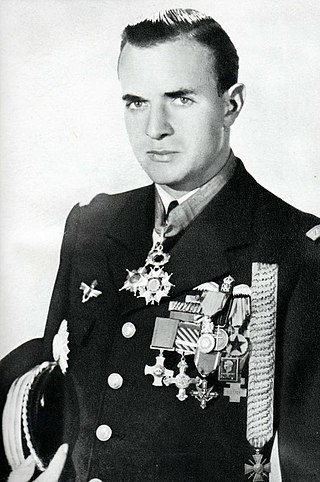
Pierre-Henri Clostermann was a World War II French ace fighter pilot.

During World War II, the Political Warfare Executive (PWE) was a British clandestine body created to produce and disseminate both white and black propaganda, with the aim of damaging enemy morale and sustaining the morale of countries occupied or allied with Nazi Germany.
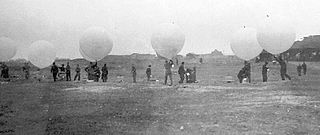
Operation Outward was a British campaign of the Second World War that attacked Germany and German-occupied Europe with free-flying balloons. It made use of cheap, simple balloons filled with hydrogen and carrying either a trailing steel wire to damage high voltage power lines by producing a short circuit, or incendiary devices to start fires in fields, forests and heathland. A total of 99,142 Outward balloons were launched; about half carried incendiaries and half carried trailing wires.
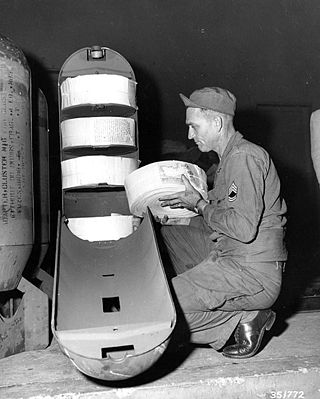
Airborne leaflet propaganda is a form of psychological warfare in which leaflets (flyers) are scattered in the air.

The Farman F.220 and its derivatives were thick-sectioned, high-winged, four engined French monoplanes from Farman Aviation Works. Based on the push-pull configuration proven by the F.211, design started in August 1925 and the first flight of the prototype was on 26 May 1932. The largest bomber to serve in France between the two world wars was the final F.222 variant. One variation was intended to be an airliner.

The Psychological Warfare Division of Supreme Headquarters Allied Expeditionary Force was a joint Anglo-American organization set-up in World War II tasked with conducting (predominantly) white tactical psychological warfare against German troops and recently liberated countries in Northwest Europe, during and after D-Day. It was headed by US Brigadier-General Robert A. McClure. The Division was formed from staff of the US Office of War Information (OWI) and Office of Strategic Services (OSS) and the British Political Warfare Executive (PWE).

Psychological operations (PSYOP) are operations to convey selected information and indicators to audiences to influence their motives and objective reasoning, and ultimately the behavior of governments, organizations, groups, and large foreign powers.

Das Reich was a weekly newspaper founded by Joseph Goebbels, the propaganda minister of Nazi Germany, in May 1940. It was published by Deutscher Verlag.

In general, philatelic fakes and forgeries are labels that look like postage stamps but have been produced to deceive or defraud. Learning to identify these can be a challenging branch of philately.

Barbara Lauwers, later known as Barbara Lauwers Podoski, was a corporal in the Women's Army Corps (WAC) and a recipient of the Bronze Star after one of her operations led to the defection of 600 soldiers from behind Italian lines and the withdrawal of their support from the Germans. She was stationed at the Office of Strategic Services (OSS) Morale Operations (MO) headquarters in Rome, Italy.
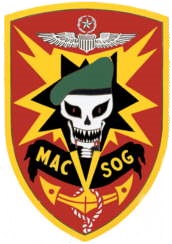
The Sacred Sword of the Patriots League (SSPL) (Mặt trận gươm thiêng ái quốc) was a sustained black operation that originated in the Central Intelligence Agency and was carried out by the Military Assistance Command, Vietnam – Studies and Observations Group (MACV-SOG) during the Vietnam War. It involved a combination of psychological warfare (PSYWAR) and psychological operations (PSYOP), today known as military information support operations (MISO).

Throughout World War II, both the Axis and Allied sides used propaganda to sway the opinions of Indian civilians and troops, while at the same time Indian nationalists applied propaganda both within and outside India to promote the cause of Indian independence.
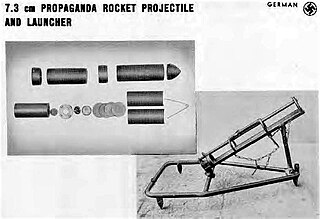
The Propagandawerfer 41 was a rocket launcher for the associated non-lethal Propagandagranate 41 rocket. The launcher and rocket were a light man-portable system fired by specially-trained propaganda troops during World War II to distribute leaflets.

Das Neue Deutschland was an alleged freedom movement that was founded by the American Office of Strategic Services (OSS) in June 1944 during the Second World War. Its main organ was a magazine of the same name, which was brought to Germany by resistance fighters, former German prisoners of war, and with the help of airplanes. The aim was to create the impression, through propagandistic articles in this magazine, that an underground movement existed on the territory of the German Reich with the intention of overthrowing the Nazi regime. In the editorial design of the magazine, care was taken to ensure that, as far as possible, no reference to hostile propaganda was discernible; it was imperative to convey the idea of an opposition independent of the Allies that existed within Germany. In order to find a meaningful name for the journal, the planning group asked for more than 30 suggestions, all of which, however, turned out to be unsuitable. Either they were names that had already been used during the Weimar Republic and thus had negative connotations, or they were names of smaller local splinter groups that had been used earlier. Since the magazine was intended to convey the idea of a new Germany after the Nazi dictatorship, the final name was eventually agreed upon, which apparently had never been used in the past either. Nevertheless it obviously had been overlooked that a monthly magazine for the "Nationalsozialistische Weltanschauung" (NS-worldview) of the same name already existed in the 1930s.

Parole der Woche was a wall newspaper published by the Reichspropagandaleitung der NSDAP from 1937 to 1943. Historian Jeffrey Herf describes Parole der Woche as "the most ubiquitous and intrusive aspect of Nazism's visual offensive ... no form of Nazi visual propaganda made so crucial a contribution to the regime's presentation of ongoing events".

The clandestine press of the French Resistance was collectively responsible for printing flyers, broadsheets, newspapers, and even books in secret in France during the German occupation of France in the Second World War. The secret press was used to disseminate the ideas of the French Resistance in cooperation with the Free French, and played an important role in the liberation of France and in the history of French journalism, particularly during the 1944 Freedom of the Press Ordinances.




















